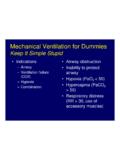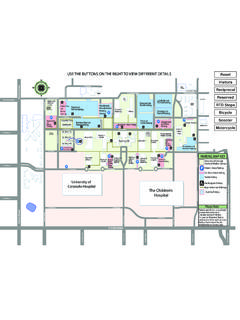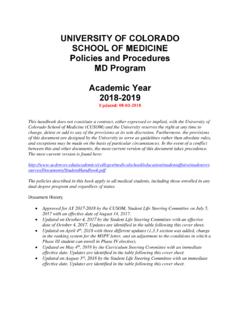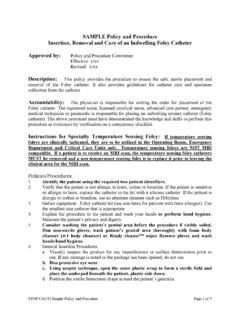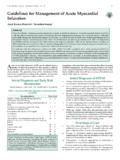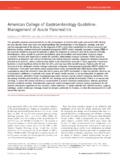Transcription of Optimal Management of Splenic/Portal Vein …
1 Optimal Management of Optimal Management of SplenicSplenic/Portal Vein /Portal Vein Thrombosis Thrombosis David David MauchleyMauchleyUniversity of ColoradoUniversity of ColoradoOverviewOverview Portal Vein Thrombosis Portal Vein Thrombosis (PVT)(PVT) EtiologyEtiology Presentation/Clinical Presentation/Clinical AspectsAspects DiagnosisDiagnosis ManagementManagement Cirrhotic vs. nonCirrhotic vs. non--cirrhoticcirrhotic Medical vs. InvasiveMedical vs. Invasive SplenicSplenicVein Thrombosis Vein Thrombosis (SVT)(SVT) Etiology Etiology Presentation/Clinical Presentation/Clinical AspectsAspects DiagnosisDiagnosis ManagementManagement Surgery vs.
2 ObservationSurgery vs. observationPVT: Management DilemmaPVT: Management Dilemma Lack of randomized Lack of randomized controlled datacontrolled data Determining acute vs. Determining acute vs. chronic diseasechronic disease Better understanding of Better understanding of etiologyetiology Perceived risks of Perceived risks of anticoagulationanticoagulationPVT: EtiologyPVT: Etiology Common causesCommon causes CirrhosisCirrhosis Coagulation abnormalitiesCoagulation abnormalities IntraIntra--abdominal infectionabdominal infection MalignancyMalignancy Umbilical vein Umbilical vein catheterization (children)catheterization (children) Uncommon CausesUncommon Causes SchistosomiasisSchistosomiasis PancreatitisPancreatitis PostsurgicalPostsurgical((splenectomyspl enectomy, liver , liver txtx)) Compression by nodesCompression by nodes Drugs (oral Drugs (oral contraceptives)contraceptives)
3 PregnancyPregnancyPVT: PresentationPVT: Presentation Can be asymptomaticCan be asymptomatic Increased hepatic arterial flowIncreased hepatic arterial flow Rapid development of collaterals (Rapid development of collaterals (cavernomatouscavernomatoustransformatio n)transformation) acute PVTA cute PVT <60 days prior to presentation<60 days prior to presentation Abdominal pain, nausea, feverAbdominal pain, nausea, fever symptoms related to extent symptoms related to extent of thrombosis (bowel ischemia)of thrombosis (bowel ischemia)
4 Absence of clinical, Absence of clinical, endoscopicendoscopicor radiological portal HTNor radiological portal HTNPVT: PresentationPVT: Presentation Chronic PVTC hronic PVT Symptoms of portal HTNS ymptoms of portal HTN VaricealVaricealbleedingbleeding AscitesAscites SplenomegalySplenomegaly BiliaryBiliaryobstruction obstruction (( cavernomacavernoma )) Growth retardation in Growth retardation in childrenchildrenPVT: Diagnosis (Ultrasound)PVT: Diagnosis (Ultrasound) Initial imaging methodInitial imaging method Color Color dopplerdopplerultrasound ultrasound has 98% neg.
5 Predictive has 98% neg. predictive valuevaluePVT: Diagnosis (MRA/CT)PVT: Diagnosis (MRA/CT) MRA as accurate as MRA as accurate as angiography in detecting angiography in detecting PVTPVT CT allows diagnosis of CT allows diagnosis of etiology (malignancy)etiology (malignancy)PVT: Diagnosis (angiography)PVT: Diagnosis (angiography) Gold standardGold standard in in diagnosisdiagnosis InvasiveInvasive Useful when planning Useful when planning shunt surgeryshunt surgeryPVT: ManagementPVT: Management Goal of Management is to reduce associated Goal of Management is to reduce associated morbidity and mortalitymorbidity and mortality Two broad intentions:Two broad intentions: Reverse or prevent advancement of thrombosisReverse or prevent advancement of thrombosis Treat complications of established PVT (mainly Treat complications of established PVT (mainly varicealvaricealbleeding)bleeding) acute PVT: AnticoagulationAcute PVT: Anticoagulation ThrombolysisThrombolysisvs.
6 Systemic anticoagulation vs. systemic anticoagulation No randomized data comparing the two methodsNo randomized data comparing the two methods Evidence that early intervention is beneficialEvidence that early intervention is beneficial MalkowskiMalkowskiet alet al(2003) studied 33 cases of acute PVT (2003) studied 33 cases of acute PVT (symptoms 8(symptoms 8--60 days prior to presentation)60 days prior to presentation) Conservative mgmt. in first 5 ptsConservative mgmt. in first 5 pts all died (all died (varicealvaricealbleeding)bleeding) ThrombolysisThrombolysisin next 28in next 28 RecanalizationRecanalizationif symptoms <14 days (n=10)if symptoms <14 days (n=10) Restoration of Restoration of hepatopetalhepatopetalflow in 13/18 remaining pts allowing flow in 13/18 remaining pts allowing normal liver functionnormal liver functionAcute PVT: AnticoagulationAcute PVT: Anticoagulation CondatCondatet al et al (2000): retrospective review of 33 (2000).
7 Retrospective review of 33 patients with acute PVT (recent patients with acute PVT (recent abdabdpain, no pain, no evidence of portal HTN, no portal collaterals on evidence of portal HTN, no portal collaterals on imaging)imaging) 27 pts received heparin/27 pts received heparin/coumadincoumadinand had followand had follow--up imagingup imaging 25 showed 25 showed recanalizationrecanalization 2 pts received no anticoagulation and showed no 2 pts received no anticoagulation and showed no recanalizationrecanalizationon followon follow--up imagingup imaging Suggests early anticoagulation results in Suggests early anticoagulation results in recanalizationrecanalizationPVT: AnticoagulationPVT.
8 Anticoagulation Use in pts with chronic PVT varies secondary to Use in pts with chronic PVT varies secondary to presumed increased risk of bleedingpresumed increased risk of bleeding CondatCondatet al et al (2001) retrospectively reviewed 136 pts (2001) retrospectively reviewed 136 pts with PVT, but no cirrhosis or malignancy (84 pts with with PVT, but no cirrhosis or malignancy (84 pts with anticoagulation, 42 without)anticoagulation, 42 without) No difference in bleeding rate, hemoglobin level on No difference in bleeding rate, hemoglobin level on admission, or subsequent transfusion requirementadmission, or subsequent transfusion requirement Anticoagulation associated with reduction in new Anticoagulation associated with reduction in new thromboticthromboticepisodesepisodes Unclear whether group without anticoagulation was a Unclear whether group without anticoagulation was a better risk group (fewer better risk group (fewer comorbiditiescomorbidities))
9 At presentation) at presentationManagement of GE Management of GE VariciesVaricies Several recent prospective randomized studies Several recent prospective randomized studies showing Bshowing B--blockade and/or blockade and/or endoscopicendoscopictherapy therapy decreases rate of first bleed/decreases rate of first bleed/rebleedrebleed All studies done on cirrhotic pts without mention of All studies done on cirrhotic pts without mention of PVTPVTMgmt of Mgmt of VaricesVaricesin pts with PVTin pts with PVT VleggaarVleggaaret al et al
10 Prospectively followed 21 pts with prospectively followed 21 pts with varicesvaricessecondary to PVT (1982secondary to PVT (1982--1997)1997) All treated with All treated with sclerotherapysclerotherapyat initial bleedat initial bleed Five pts Five pts rebledrebledand were again treated with and were again treated with sclerotherapysclerotherapy(two had subsequent shunt procedure)(two had subsequent shunt procedure) Pts had 95% survival at five yearsPts had 95% survival at five years 2 pts died from malignancy2 pts died from malignancy 0 pts died from 0 pts died from varicealvaricealbleedingbleeding Conclusion: Conclusion.
